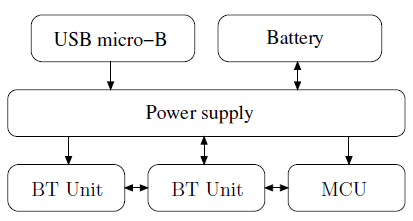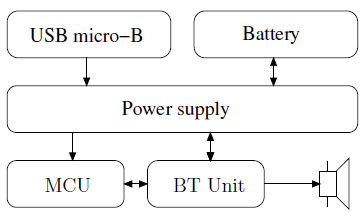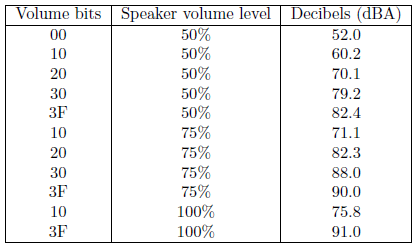ABSTRACT
Our group designed and built a stereo network that streams audio from a Bluetooth-enabled device and automatically handles playback from the speakers closest to the user. The system is comprised of a hub to which the user’s device connects to, and speaker adapters, which enable any speaker with a 3.5mm audio jack to interface wirelessly to our hub.
Each unit consists of a Bluetooth chip and a microcontroller. The hub broadcasts audio to the speaker adapter, which is constantly sending back signal strength data about the user’s audio device. Each of our components is powered by a lithium-ion battery and charged over USB. With our Bluetooth stereo network, a user can enjoy his/her music uninterrupted from the living room to the bedroom without having to worry about connecting or muting any speakers.
DESIGN

Figure 2: Hub block diagram.
The hub is responsible for streaming the wireless audio that it receives from the UE to the speaker adapters. It also receives RSSI values indicating adapter proximity to UE via the BT RFComm channel from the speaker adapters; the hub selects the adapter to stream to based on the RSSI values that it receives. A high-level block diagram of the hub is shown in Figure 2.

Figure 3: Speaker adapter block diagram.
The speaker adapter converts any standard o -the-shelf speakers with a 3.5mm audio jack into wireless BT speakers. It also records the RSSI values of the UE within its proximity and transmits this data back to the hub so that the hub can select the appropriate speaker to stream to. The high-level block diagram of the speaker adapter is shown in Figure 3.
REQUIREMENTS & VERIFICATION
The rst requirement was to have enough programmable microcontrollers to insert into each of our modules. The PCB designed for the MSP430 includes header pins for connectivity to the MSP-FET430UIF USB Debugging Interface. We chose to forgo using such development tools as Launchpads and Arduinos as we wanted to develop as much of a nal product as we could.

Table 3: Audio amplifier performance.
On the speaker adapter end the audio frontend must also provide proper playback out of the analog audio jack into the speaker itself. Simply hearing audio is not a sufficient enough test, as we previously quantified our sound measurements and measured the performance of the now-defunct amplifier using the decibel meter 1800 away from the the speaker. We adjusted the volume two ways. First, by sending the I2C commands to reset the register 0x02. The audio amplifier volume ranges from 00 for mute up to 3F. Second, by physical control of the volume knob on the speakers. The results we captured are shown in Table 3.
COSTS
Since our device is the only device that provides proximity based playback, and is compatible with any Bluetooth audio device without the need for any special app (iOS, Android, etc.), we expect there to be a significant market for this system. A notable wireless streaming system by Sonos, does allow streaming to specific speakers using a mobile app to control playback, but speakers for the system go well beyond the $300 range. Additionally, if the user lacks an Android or “iDevice,” the user must buy a proprietary remote for $349, putting the Sonos system out of range for most consumers.
Parts
Each of the WT32 modules cost $30. When ordered for mass production, the cost drops to $24. When considering all such parts in mass quantities, including 2-layer PCB with bottom side silk-screen, we estimate the cost to be around $50 per unit, bringing our parts cost down to $150 from $161:09.
Labor
These costs are built on the assumption each of us worked 10 hours a week on the project though in reality our time worked on project skyrocketed in the nal week or two. However sticking with our estimated 150 hours worked at a rate of $75 per hour, our total non-parts cost is $84; 375.
CONCLUSIONS
Through our work over the course of the semester, we have successfully demonstrated a Bluetooth stereo network that plays to the speakers closest to the user. By walking across a room from one set of speakers to another, we observed audio switch automatically to the speaker beside the user. Thus, our project provides the solution to streaming music to different rooms without automatic audio packet switching between speakers.
Our project was successful, but there are certainly improvements and modifications that we can work on in the future. The most obvious undertaking is the audio quality. By using analog audio in, we experienced much degradation in our sound coming from the UE. This is something that can be avoided by implementing an all-digital receiver frontend, and using the I2S audio we demonstrated in out mockup, or by improving our wiring on all the analog inputs/outputs.
This digital frontend is not without tradeoffs, however, as we found our final design to be newly compatible with any audio device, not just Bluetooth enabled-ones. Should we decide universal compatibility is important enough proceed with our current design, improving audio quality is a matter of improved soldering and wiring on the analog inputs and outputs.
Source: University of Illinois
Authors: Je Wheeler | Rishi Ratan | Jerry Sun
>> More Wireless Projects using Arduino for Engineering Students
>> More Wireless Bluetooth Projects for Final Year Students
>> More Wireless Projects Using Microcontroller for Engineering Students